Warwickshire Dragonfly
Group - News page
Table of Latest Flight
dates
Table of Earliest Flight dates
November 20th 2015 -
Latest ever record of flying Southern Hawker for
Warwickshire
November 7th 2015 - Autumn
dragonflies and damselflies.
September 23rd 2015 -
Dragonflies and damselflies still active
August 27th 2015 - Migrant Hawker now
flying in the county - this completes the list adult
county breeding species seen this year.
August 13th 2015 - Small
Red-eyed Damselfly is now flying but the list for 2015
is still incomplete.
July 16th 2015 - Scarce
Chaser seen, Hairy Dragonfly at Brandon Marsh and
nearly all our breeding species now flying.
May 29th 2015 -
Black-tailed Skimmer flying.
May 26th 2015 - Four
more species are flying and revised entry in the first
flights table.
May 14th 2015 - Banded
Demoiselle and Broad-bodied Chaser both flying plus a
good haul of Hairy Dragonfly exuvia and an emergent at
Stockton Quarry.
May 8th 2015 - First
reports of flying Hairy Dragonfly on 4th
May and Blue-tailed Damselfly on 7th May.
May 4th 2015 - First
report of flying Four-spotted Chaser on 1st
May.
May 3rd 2015 - First
report of flying Azure Damselfly.
April 26th 2015 - Large
Red Damselfly now flying widely across the county.
April 18th 2015 - First
flying Large Red Damselfly of 2015. Updated 20
April!
February 16th 2015 -
Report of David Chelmick's lecture.
February 2015 - Report for 2014
published in the BDS Darter journal.
Table
of Latest Dates Recorded in Warwickshire
Species
|
Date 2015
|
Latest before 2015
|
Site for 2015
|
Recorder 2015
|
| Azure
Damselfly.
|
22.8.2015
|
15.9.1969
|
Tithe
Farm Pond
|
Kay
& Peter Reeve |
| Azure
Damselfly.
|
22.8.2015
|
15.9.1969
|
Bubbenhall
Meadow
|
Jim
Timms |
| Azure
Damselfly.
|
22.8.2015
|
15.9.1969
|
Middleton
Lakes, RSPB Reserve
|
Member
RSPB team |
| Banded
Demoiselle.
|
28.8.2015
|
3.11.1995
|
Oxford
Canal, The Tunnel, Fenny Compton
|
Jon
Bowley |
| Beautiful
Demoiselle.
|
16.7.2015
|
3.9.2012
|
Long
Brook Meadow, Balsall
|
Jon
Bowley |
| Black-tailed
Skimmer.
|
6.9.2015
|
14.9.2008
|
Salford
Priors
|
Jon
Bowley |
| Blue-tailed
Damselfly.
|
2.10.2015
|
12.10.1990
|
Hartshill
Hays, Nuneaton.
|
John
Harris |
| Broad-bodied
Chaser.
|
22.8.2015
|
31.8.1992
|
Tithe
Farm Pond
|
Kay
& Peter Reeve |
| Brown
Hawker.
|
8.10.2015
|
27.10.2014
|
Wormleighton
Reservoir.
|
Jon
Bowley |
| Common
Blue Damselfly.
|
27.9.2015
|
17.11.2011
|
Blythe
Valley Country Park, Pond
|
Kay
& Peter Reeve |
| Common
Darter.
|
15.11.2015
|
6.12.2009
|
Salford
Priors
|
Jon
Bowley |
| Emerald
Damselfly.
|
2.10.2015
|
28.9.1986
|
Lighthorne
Heath Quarry
|
Kay
& Peter Reeve |
| Emperor
Dragonfly.
|
18.9.2015
|
12.10.2012
|
Baddesley
Common, Settling Pools
|
Ron
Thomas |
| Four-spotted
Chaser.
|
31.7.2015
|
1.9.2009
|
Tarmac
Quarry, Purley Chase. Mancetter.
|
John
Harris |
| Four-spotted
Chaser.
|
31.7.2015
|
1.9.2009
|
Bubbenhall
Meadow
|
Jim
Timms |
| Hairy
Dragonfly.
|
10.6.2015
|
2.7.2009
|
Stockton
Quarry
|
Kay
& Peter Reeve |
| Large
Red Damselfly.
|
15.7.2015
|
31.8.1983
|
Alvecote
Wood
|
Kay
& Peter Reeve |
| Migrant
Hawker.
|
4.11.2015
|
20.11.2014
|
Dost
Hill
|
John
Harris |
| Red-eyed
Damselfly.
|
11.9.2015
|
15.9.2012
|
Brandon
Marsh
|
Jim
Timms |
| Ruddy
Darter.
|
2.10.2015
|
25.10.2011
|
Lighthorne
Heath Quarry
|
Kay
& Peter Reeve |
| Scarce
Blue-tailed Damselfly.
|
16.8.2015
|
26.8.2007
|
Salford
Priors
|
Jon
Bowley |
| Scarce
Chaser.
|
18.7.2015
|
5.7.2012
|
Avon,
Charlecote Park R Avon
|
Kay
& Peter Reeve |
| Small
Red-eyed Damselfly.
|
30.9.2015
|
9.9.2012
|
Berryfield
Pool
|
Kay
& Peter Reeve |
| Southern
Hawker.
|
12.11.2015
|
9.11.2006
|
Ryton
Wood
|
Jim
Timms |
| White-legged
Damselfly.
|
9.8.2015
|
15.9.1969
|
Stockton
Quarry
|
Kay
& Peter Reeve |
If you have any later dates for 2015 or later times for
previous years please let me have them.
Back to page top
Table
of Earliest Dates Recorded in Warwickshire
Species
|
Date 2015
|
Earliest before 2015
|
Site for 2015
|
Recorder 2015
|
| Azure
Damselfly. |
3.5.2015
|
28.4.2011
|
Brandon
Marsh
|
Ian
Harris |
| Banded
Demoiselle. |
8.5.2015
|
20.4.2011
|
Middleton
Lakes, RSPB Reserve
|
Katie
Thorpe |
| Beautiful
Demoiselle. |
22.5.2015
|
30.4.2011
|
Morton
Bagot, near Stapenhill Wood
|
R.E.
Harbird |
| Black-tailed
Skimmer. |
28.5.2015
|
6.5.2011
|
Southam
Old Quarry
|
Glyn
Clarke |
| Blue-tailed
Damselfly. |
7.5.2015
|
22.4.2011
|
Avon,
Brandon Marsh
|
Ian
Harris |
| Broad-bodied
Chaser. |
11.5.2015
|
23.4.2011
|
Ufton
Fields
|
Kay
& Peter Reeve |
| Brown
Hawker. |
19.6.2015
|
19.5.1982
|
Purley
Chase Lane quarry, Mancetter
|
John
Harris |
| Common
Blue Damselfly. |
16.5.2015
|
23.4.2011
|
Middleton
Lakes RSPB Reserve, New south pond.
|
Member
RSPB team |
| Common
Darter. |
14.6.2015
|
10.5.1982
|
Salford
Priors
|
Jon
Bowley |
| Emerald
Damselfly. |
24.6.2015
|
21.5.2007
|
Heart
of England Forest., Purity brewing water treatment
pools.
|
Mick
Schilling |
| Emperor
Dragonfly. |
7.6.2015
|
13.5.2011
|
Mancetter
Quarry Pools
|
Keith
Warmington |
| Four-spotted
Chaser. |
1.5.2015
|
23.4.2011
|
Bubbenhall
Meadow
|
Jim
Timms |
| Hairy
Dragonfly. |
3.5.2015
|
26.4.2007
|
Stockton
Cutting.
|
Andrew
Pitt |
| Large
Red Damselfly. |
16.4.2015
|
12.4.2011
|
Stretton-on-Fosse
|
Phillip
Clayton |
| Migrant
Hawker. |
12.7.2015
|
18.6.1996
|
Finham
Brook, Kenilworth
|
Ron
Thomas |
| Red-eyed
Damselfly. |
21.5.2015
|
2.5.2011
|
Brandon
Marsh
|
Ian
Harris |
| Ruddy
Darter. |
8.7.2015
|
24.6.2002
|
Brandon
Marsh
|
Dave
Mount |
| Scarce
Blue-tailed Damselfly. |
14.6.2015
|
18.5.2014
|
Salford
Priors
|
Jon
Bowley |
| Scarce
Chaser. |
5.7.2015
|
12.6.2014
|
Avon,
Charlecote Park R Avon
|
Mick
Schilling |
| Small
Red-eyed Damselfly. |
25.7.2015
|
19.6.2014
|
Alvecote
Pooley Fields, Canal Pool
|
Kay
& Peter Reeve |
| Southern
Hawker. |
14.6.2015
|
10.5.1982
|
Salford
Priors
|
Jon
Bowley |
| White-legged
Damselfly. |
16.5.2015
|
14.5.2003
|
Mappleborough
Green - private pool
|
Mick
Schilling |
If you have any earlier dates for 2015 or earlier times
for previous years please let me have them.
Back to page top
November
20th Latest ever record of flying Southern
Hawker for Warwickshire.
There have been a number of late sightings of Southern Hawker.
Two were record late dates for the county. Keith
Warmington saw a female in his garden at Baddesley
Ensor on 10th November and it was the
latest date for only two days. On the 12th
November Jim Timms sighted one in Ryton Wood. This is
now the latest date for a flying Southern Hawker in
Warwickshire.
Some late records for Common
Darter have been received, see the last flights table for the latest.
Will we have any more records in 2015? Perhaps not.
The cold weather predicted for the next few days may
prove to be the finish of the 2015 flight season. But
keep looking.
Back to page top
November
7th Autumn dragonflies and damselflies.
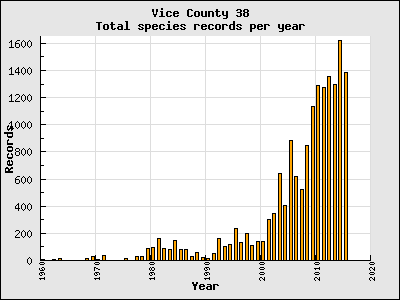
|
There are now
few species left flying. Southern
Hawker, Migrant Hawker
and Common
Darter are the latest recorded species -
see the last flights table
for their and other species dates.
For one species, Emerald
Damselfly, three rather tired males were
seen at Lighthorne on 2nd October,
this is the latest record for the species in
Warwickshire.
Not many more records can be expected this year,
though the weather has remained warm and so some
are to be expected. This year the total number
of records as of 7 November is 1386. This
compares well with the last few years as the
graph shows. |
Back to page top
September
23rd Dragonflies and damselflies still
active
There are still a lot of dragonflies to be seen flying
and they will continue in declining number well into
November or even early December - if the weather is
kind. It is a time to try and find the latest flying
individuals of species - for many we have already seen
the last of them for this year. The current situation
can be seen in the last flights table
above. However, this will not the last word this year -
get out and see what you can find. On a visit to Brandon
Marsh this afternoon, 23rd September, it was
rather cool (14 to 16ºC) and fairly cloudy but within
less than a minute into the sunny periods dragonflies
were up and flying and desperate to breed. Migrant
Hawkers, Common Darters, Common Blue Damselfly and
Red-eyed Damselfly were all apparent and showing
breeding behaviour.
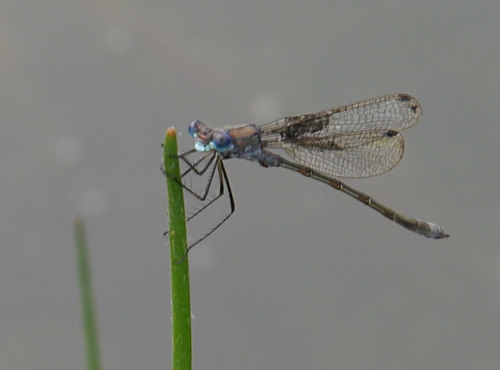
Larger
image.
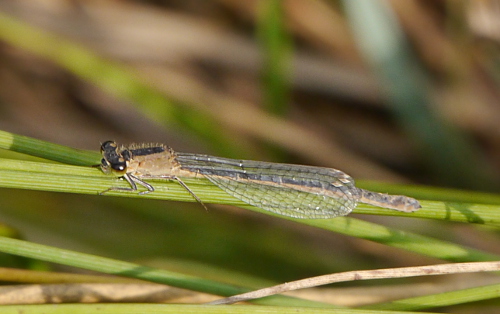
Larger
image.
|
Late in the year
there are still interesting things to be seen.For
example, these two individuals photographed at
Marsh Lane Reserve on 19 September caused Kay and
Peter Reeve to look more than once in order to
identify them. Have a go at naming the species.
Answers here.
We also saw several dead Common Blue Damselflies
in the water that were still fully coloured and
could not have been dead long. Then while looking
at a Common Blue it attempted to fly from an
emergent reed stem and immediately fell into the
water - it was too weak get itself out. Clearly,
they were, literally, falling of their perches.
Sex and age had worn them out!
A few days earlier a strange attempt at mating was
seen at Berryfield Pool. A Migrant Hawker male was
flying in tandem with a South Hawker female. She
was attempting to get into the wheel position
while they flew but after failing several times
the pair broke up. It is indicative of the intense
desire to mate - time is running out.
You continue to send in records and the total for
this year now exceeds a thousand. Quite a number
are for sightings made earlier in the year and
more are expected to come in before the end of the
year. If you still have records that you have not
submitted it will be helpful if you do so as soon
as you can.
|
Back to page top.
August
27th Migrant Hawker now flying in the
county - this completes the list adult county breeding
species seen this year.
Since the August 13th article, below, a
considerable number of records have been received. These
include the first reports for Migrant Hawker and
a number of records for earlier in the year. The early
records have resulted in a considerable change to the first flights table.
The first sighting of flying Migrant Hawker this year
was made by Jon Bowley at Wormleighton Reservoir on July
28th. There were three more Migrant Hawker
records before August 13th and three
following that date. They are now flying quite widely
across the county.
Other species that are still in considerable number at
some sites are: Red-eyed
Damselfly, Small Red-eyed
Damselflies and Brown Hawker.
All the records so far received have been processed and
the website updated. The total of records received so
far this year is 730. How many more will be made this
year?
Back to page top
August
13th Small Red-eyed Damselfly
is now flying but the list for 2015 is still
incomplete.
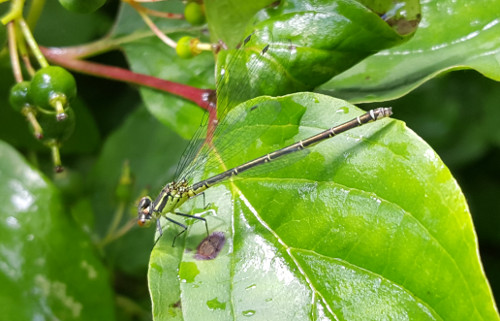
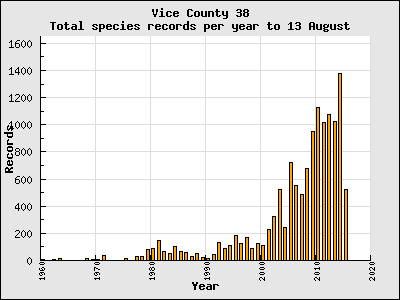
|
The first 2015 VC38
flying Small
Red-eyed Damselflies, a tandem pair, were
seen at Alvecote Pooley Fields by Kay and Peter
Reeve on July 25. Just two days later Ben Devine
photographed this female at Brandon Marsh. Several
more individuals have been seen since at two other
sites. However, numbers have been small.
Still missing from the county's known
breeding species is a report for Migrant Hawker.
This species should be about now. All others have
now been seen as adults, see the first flights table, though
quite often in relatively small numbers. So far we
have not had any exotic vagrant in Warwickshire
this year.
So far, the number of records received to 13th
August is well below the numbers for the same
period in the previous six years, see the
histogram on the left. Are there still many
records to come in or has the poor weather this
year resulted in less opportunity to record? If
you have more records to supply please send them
in.
|
Back to page top
July 16th Scarce Chaser at
Charlecote and almost all VC38 breeding species
flying.
| Scarce
Chaser at Charlecote Park |
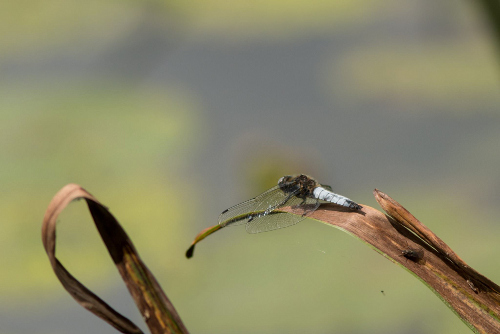
|
Excellent news about the Scarce Chaser.
Mick Schilling saw a single male shown to the left
on the Avon at Charlecote Park on 5th
July. This is an exciting record, the first in an
odd year. Mick's record was followed up by the
sighting of two males at almost exactly the same
location by Kay and Peter Reeve on 10th July.
Previous sightings were in 2010 (FCR), 2012 and
2014, years that fit with the normal two year
breeding cycle. This year's records suggest a new
immigration, these individuals are well upstream
of previous sightings, or it might be the first
signs of "leakage" into odd years from the even
year population. |
|
First Hairy
Dragonfly seen at Brandon Marsh
|
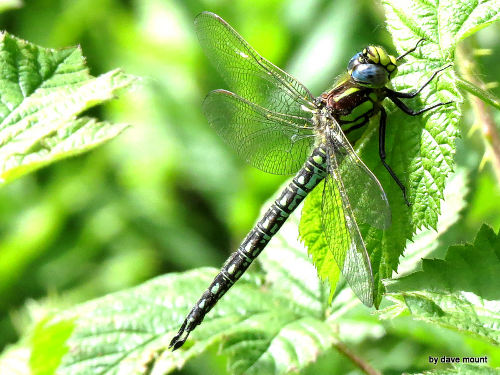
|
This is another
piece of good news. Dave Mount photographed
this Hairy
Dragonfly at Brandon Marsh 2nd
June. He sighted it, or others, on several
succeeding days. There is plenty of perfect
habitat for this species on the reserve - we have
been waiting for the first one to be reported. It
is now very late to expect more sightings but next
year searches can be made in May for signs of
breeding.
|
Almost all
Warwickshire breeding species are now flying
|
With
the exception of Small Red-eyed Damselfly and
Club-tailed Dragonfly, all our breeding species
are now flying. It is still early for Small
Red-eye - for which we can soon expect the first
record. However, for the Club-tailed Dragonfly it
is now very late and unlikely to be seen this
year. The very sparse number of records for this
species in the last few years is worrying. The
number of recorded sightings and exuvia found
dropped suddenly in 2010 and has not recovered.
The flight table list all
the species seen this year, when, where and by
whom. One species worthy of comment is Scarce
Blue-tailed Damselfly. Jon Bailey reported
one male on 14th June - it is still
holding on.
|
Back to page top
May
29th Black-tailed Skimmer flying.
Glyn Clarke saw two Black-tailed
Skimmers at Southam Old Quarry 28 May the first
record for flying individuals in the county received
this year.
Back to page top
May
26th Four more species are flying and
revised entry in the first flights table.
The following four species are now flying. This makes ten
species that have been recorded as adults in Warwickshire
this year, see the first flights
table.
| Red-eyed Damselfly - 21st
May. |
| The first adult Red-eyed
Damselfly was recorded at Brandon Marsh by
Ian Harris. |
Beautiful Demoiselle - 22nd May. |
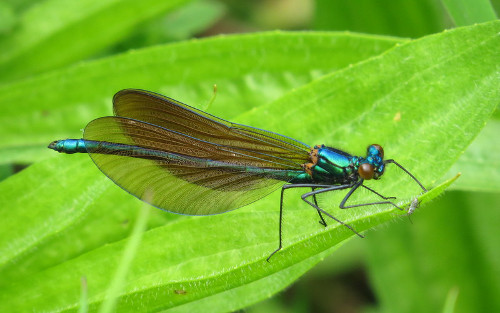 |
Richard Harbird found and photographed this
freshly emerged Beautiful
Demoiselle at Morton Bagot. The same day
Kay & Peter Reeve looked for the species on
the Leam at Wolfhamcote, a known breeding site,
and did not find it.
|
White-legged Damselfly - 23rd May. |
| A number of newly emerged White-legged
Damselfly were seen by Kay & Peter Reeve
on the Avon at Marlcliff. Kay also found an exuvia
of the species. |
Common Blue Damselfly - 25th May. |
| Kay & Peter Reeve also saw
several newly emerged Common
Blue Damselflies Napton Reservoir. |
First flights table and comments. |
|
The first flights table
has been updated with the above observations and
the entry for Hairy Dragonfly moved one day
earlier. Andrew Pitt spotted one at Stockton
Railway Cutting on 3 May.
|
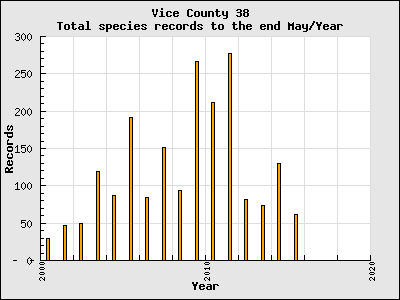 |
The
count of species flying is gradually rising. But
the numbers of records received so far this year
low compared with most earlier years of the
millennium. This particularly case compared to the
years 2009/10/11 which had warm early springs. The
cool weather this spring both retards the date
species emerge and numbers of emerging
individuals. It also tends to put off recorders
from going out into the field - so do we miss
things? |
Back to page top
May
14th Banded Demoiselle and Broad-bodied
Chaser both flying plus a good haul of Hairy Dragonfly
exuvia and an emergent at Stockton Quarry.
Two more species now flying are the Banded
Demoiselle and the Broad-bodied
Chaser. The first Banded Demoiselle was recorded
by Katie Thorpe at Middleton Lakes on 7th
May. It was seen the next day in numbers at Brandon
Marsh and the Avon at Bidford-on-Avon. The first flights table is updated.
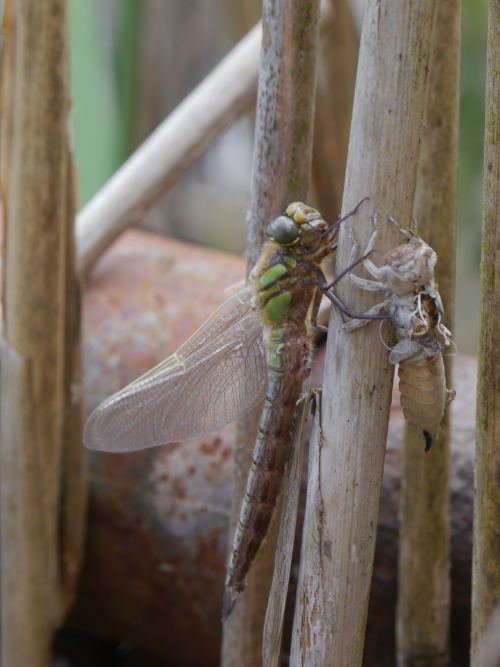 |
Kay and Peter Reeve made a visit to Stockton
Quarry on 12th May to look for signs
of the breeding population of Hairy
Dragonfly. After some searching they were
rewarded by finding ten exuvia and the emergent
male shown in the picture. This population
continues to be healthy.
|
Back to page top
May
8th First reports of flying Hairy Dragonfly
on 4th May and Blue-tailed Damselfly on 7th
May.
Ian Harris has been at work again at Brandon and found
three Blue-tailed
Damselflies on the Avon bank 7th May.
The individual in the picture has probably been out a
day or two.
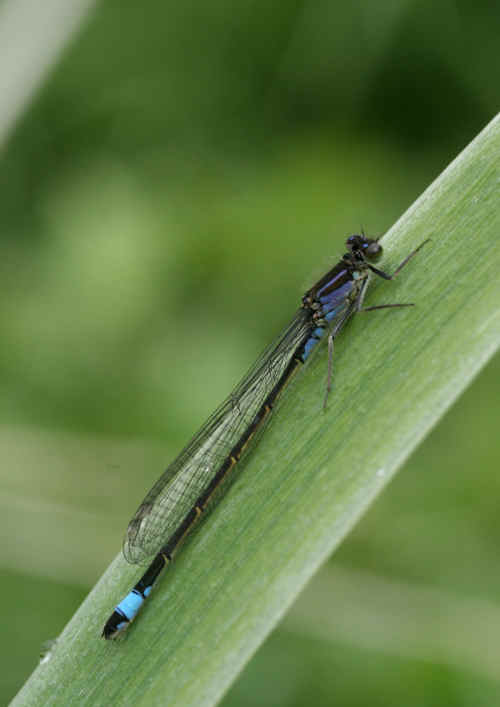 |
Sarah Walters sent the following in an email on 4th
May:
"Just to let you
know I saw a large dark hawker dragonfly in
Alvecote Wood today. I didn't get a photo but
almost certain it was a hairy dragonfly.
That's really all it could be at this time of
year."
After thinking about I have to agree so we have
our first flying Hairy
Dragonfly of the year. |
Back to page top
May
3rd First report of flying Four-spotted
Chaser.
A single Four-spotted
Chaser was recorded at Bubbenhall Meadow on 1st
May. It was reported late by Jim Timms who was diverted
by a Hudsonian Goodwit that appeared in Somerset!
It is not a paticularly early specimen as the first flights table shows.
Back to page top
May
3rd First report of flying Azure Damselfly.
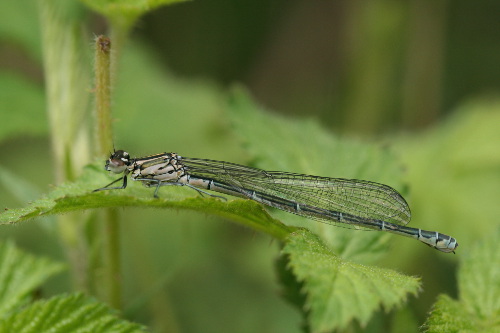 |
Ian Harris spotted this female Azure
Damselfly at Brandon Marsh on 3rd
May. It is recently emerged. As the first flights table shows,
it is fairly early. The only year with earlier
records is 2011 which was very warm from the new
year into spring. There was a record in 2007 on
the same day.
|
Back to page top
April
26th Large Red Damselfly now flying widely
across the county.
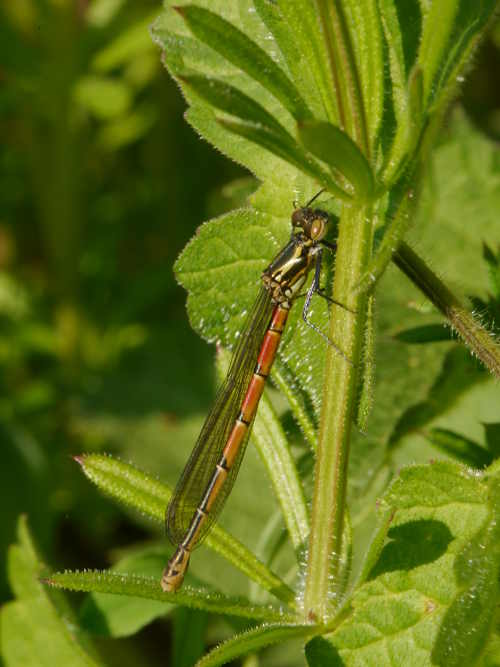 |
The Large
Red Damselflies has now been seen widely
across Warwickshire though still in small
numbers.
The picture shows a Large Red Damselfly at
Marsh Lane Reserve photographed 21st
April.
|
Back to page top
April
18th First flying Large Red Damselfly of
2015.
UPDATE - Phil Clayton has just sent in a
record for one LRD at Stretton-on-Fosse for 16th
April, only four days later than our earliest.
The first county report of adult damselflies of 2015
has been received from Glyn Clarke, 4 adult Large Red
Damselflies at Stockton.
This is two days later than last year and six later
than the county earliest - see first
flights and 16 days later than the earliest record
for the UK this year on the BDS
website.
Back to page top
February
16th 2015 - Report of David Chelmick's
lecture..
 David Chelmick
gave an informative, thought provoking and entertaining
lecture. David Chelmick
gave an informative, thought provoking and entertaining
lecture.
He started with a description of visits to his son in
Dubai on the Persian Gulf. The surprise on his first
visit was the dragonfly fauna he found in this desert
city. Dragonflies and damselflies were exploiting all
the water bodies available - park lakes, pools formed by
leaking water mains (even though almost all fresh water
is obtained by desalination there seems to be no urgency
to repair!), etc. During his stays he travelled into the
desert to visit oases and even found streams with
breeding dragonflies.
However, the core of his lecture was the description of
some fascinating aspects of the reproduction biology of
dragonflies and damselflies.
David has made a special study of the Blue-tailed
Damselfly (Ischnura) genus. One species of great
interest is the Citrine Forktail, I. hastata.
This is an American species. In Europe it breeds only in
the Azores and the unique feature of its biology there
is that only females are found and so they must
reproduce by parthenogenesis. - the only species of
dragonfly known
to do so.
Another feature of species in this genus is that they
are often have a very wide global distribution. Most of
the many genera in the family Coenagrionidae, to which
Blue-tails belong, have more species with a more local
distribution.
David has put these facts together with other aspects
of Blue-tail biology and behaviour to propose a very
interesting hypothesis, that:
In the
genus of Blue-tailed damselflies parthenogenesis is much
more widespread than is assumed
even though sexual reproduction may be the norm.
The presence of parthenogenesis in the genus could help
solve the problem of its "unique" appearance in the
Citrine Forktail on the Azores - only females colonised
the islands hence only parthenogenesis could sustain a
population. Also parthenogenesis tends to slow the rate
with which evolution produces new species. This helps
explain the wide distribution of Blue-tail species -
parthenogenesis slows the rate of evolution.
The hypothesis can be proved or disproved by careful
experimentation. David has suggested projects on
Blue-tails to a number of academics but their response
is that although very interesting there was no chance of
getting any funding because Blue-tails are such a common
and numerous insects. If they were rare or threatened it
would be a different story!
Perhaps we should look at our common Blue-tailed
Damselfly with more interest. Is some cryptic
parthenogenetic reproduction happening in our
population?
Lest this report give the impression that the lecture
was heavy going, it was not. David leavened his talk
with anecdote and wit and made light work of the more
technical parts.
Thank you David for your most interesting and thought
provoking lecture.
Back to page top
February 16th 2015 - Report for 2014
published in the BDS Darter journal.
The BDS publishes the "Darter" every year. It is a
communication journal for the county recorders. Below is
article supplied to the journal Warwickshire, VC 38.
Warwickshire – VC 38
Kay & Peter Reeve
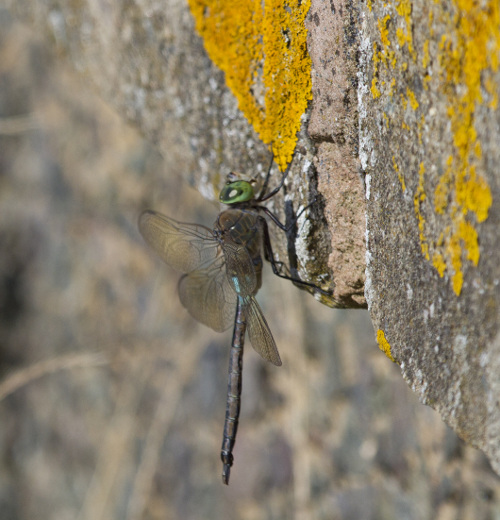
It was very pleasing to receive our highest
annual number of records for the county in 2014
- a total of 1623 records. It follows about ten
years of being motivated to collect records for
the new atlas – it is a pleasant surprise.
There was one notable vagrant sighted during
the year, the Lesser Emperor Anax
parthenope. Steve Batt snapped this at
Draycote Water 7 July. It was only perched for a
few seconds but it was sufficient for Steve to
get this grab shot. The species has now been
recorded in the county in 2011, 2013 and 2014.
Des Jennings made several very interesting
sightings of Beautiful Demoiselle Calopteryx
virgo on the River Cole. This river rises
in the centre of Birmingham and runs south more
or less along the VC38/VC37 border. Des's
sightings are well into the suburban area of
Solihull and are the first records noted for the
area since 1900. A likely factor in its
reappearance is improved water quality.
The Scarce Blue-tailed Damselfly Ischnura
pumilio is still at its one known breeding
site in VC38. Unfortunately, the quarry has
ceased production and appropriate breeding
habitat is becoming more and more scarce. The
long term outlook for the population seems
bleak.
Hairy Dragonfly Brachytron pratense
and Scarce Chaser Libellula fulva
were both recorded in numbers but, as reported
in last year’s Darter, the status Club-tailed
Dragonfly Gomphus vulgatissimus on
the Avon is worrying. Only one adult was seen on
the river in 2014. However, a single exuvia
found by the river proves it still breeds in the
county.
|
Back to page top
Banner artwork by Joan Sharrett
|
Last updated Fri Apr 22 17:23:20 2016
|
Visits since Oct 2010: 6908 | | 






 David Chelmick
gave an informative, thought provoking and entertaining
lecture.
David Chelmick
gave an informative, thought provoking and entertaining
lecture.